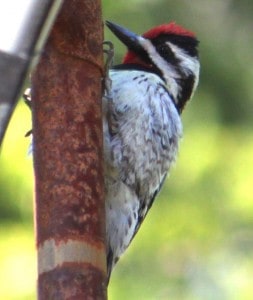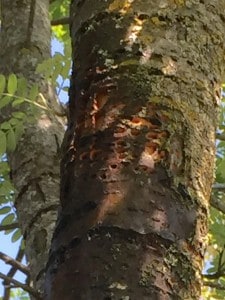Here are some comments that Bill Snowden, a retired horticulturalist, sent along regarding concern expressed by Rob Tonus about Yellow-bellied Sapsucker drillings in his mountain-ash. Rob’s response to Bill’s comments are included below.
When the Yellow-beliied Sapsucker taps mountain-ash, it will sometimes enlarge the holes daily to keep the sap running. This can be a problem since the tree can lose valuable nutrients, and the wound may get infected causing serious damage. Even drilling a series holes around the circumference can do serious damage if they are close together and girdling occurs. Unfortunately, if the sapsucker finds a tree that is a good bleeder, it will return each year, re-tap, and possibly do more damage, usually in the same area. If a protective coat of tree emulsion is put over the damaged area, the birds usually just move to a new area on the same tree.
On the road allowance at my property in Ennismore, two mountain-ashes were planted with birch and pussy willow. Over the past five years, only one of the mountain-ash has been taped repeatedly. The run of sap usually dries up by the end of June. It is interesting to watch the antics of the breeding pair, and I enjoy the continual drumming of the male. Both male and female come to the wound and drink repeatedly during the day. These trees are all European mountain-ash and the species is not a cultivar. Some of the cultivars are not visited by sapsuckers. The two trees mentioned produce good fruit but are not eaten by the birds though the parent tree is usually stripped by American Robins and Cedar Waxwings by late August. There must be a preference in taste.
Bill Snowden, Ennismore
I’m not too concerned about sapsucker damage to my tree, since they have been making holes on this tree for longer than the 15 years that we’ve lived here on the edge of Peterborough. However, the holes in a couple of locations are larger than they normally are, so I was a bit worried about excess sap flow or the introduction of fungi. I’ll just have to see how this pans out. I might cover up some of them with the emulsion Bill Snowden recommends. I find it a thrill to have lunch or dinner at the table nearby and hear that squeaky noise the bird makes when it arrives at the tree. And yes, the waxwings love the fruit – the flocks arrive in the fall and strip the tree bare in a couple of days. We certainly have chosen a great city – Peterborough – to move to!
Rob Tonus, Peterborough

